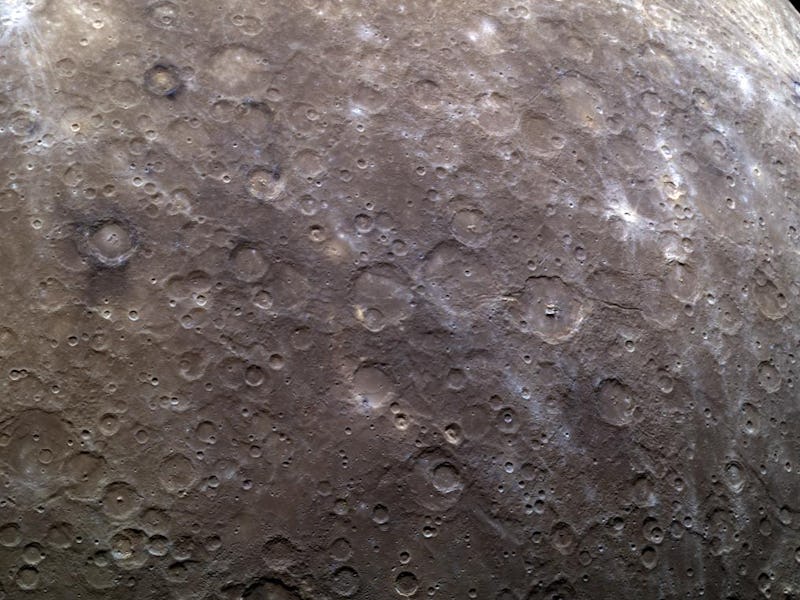In one of the Solar System's unlikeliest places, scientists find signs of life
It probably wasn’t a fun place to live, though.

On the list of places in our Solar System that may have been habitable at one point, this chaotic, burning hot planet probably comes in last.
Time to think again.
In a counterintuitive new study, researchers suggests that Mercury's chaotic terrain may have once hosted life.
It is difficult to understand how this planet could possibly be described as "habitable."
As the planet nearest to the Sun, Mercury boasts extreme temperatures unlike anything we will ever know on Earth. In the day, the planet's surface sky rockets to up to 430 degrees Celsius. At night, temperatures drop below minus 180 degrees Celsius. The planet also has a very thin atmosphere, no air pressure, endures intense solar radiation, and very long days (one day on Mercury is the equivalent of 59 Earth days.)
Not exactly be ideal for life, by our standards.
Mercury boasts intense solar radiation and very long days, but it could have hosted some form of life beneath its surface.
But the new study claims otherwise, arguing that some parts of Mercury’s subsurface were, at least at one time, capable of fostering prebiotic chemistry, and maybe a simple life form.
The paper was published this week in the journal Nature Scientific Reports.
The results suggest that we need to rethink what a "habitable planet" may look like, as similarly inhospitable planets elsewhere in the universe may be capable of hosting life, too.
Chaos above, chaos below
The idea stems from data collected during a geological examination of the planet’s terrain, conducted by NASA’s MESSENGER (MErcury Surface, Space ENvironment, GEochemistry, and Ranging) spacecraft.
The data build on an earlier survey of Mercury, Mariner 10, which NASA launched in 1973 to observe Mercury and Venus. In 1973, NASA launched a space probe to observe Mercury and Venus. The craft conducted three flybys of Mercury, the closest one was on March 16, 1975.
From above, scientists first glimpsed Mercury’s chaotic terrain. What they saw might have made anyone write it off as a potential harbor for life.
The planet’s surface was marked by a huge impact basin, one of the largest in the Solar System, which they named Caloris. Caloris stretches across 800 miles in diameter, with parts of it obscured from sunlight.
Carolis basin as seen by Mariner 10.
Across from Caloris lies a region of deep valleys and large mountains, reflecting Mercury's overly cratered landscape. Through initial observations, scientists believed that this chaotic terrain was the result of both Mercury quakes and ejecta from the impact that created Caloris.
But the impact basin may have little to do with the planet's terrain, the MESSENGER data reveals.
Instead, it appears that Mercury's surface was still under formation as recently as 1.8 billion years ago — around 2 billion years after Caloris formed.
This is the alternative the researchers behind this study propose: The landscape was produced by the removal of upper crust volatiles, which are a class of chemical compound. That means Mercury once had a thick, chemical-rich crust stretching a few kilometers deep.
If true, then Mercury’s subsurface may have been capable of hosting prebiotic chemistry at some point during the planet’s early years — and perhaps forms of simple life beneath its surface.
The chaotic terrain, outlined in white, may be the clue to life on Mercury.
“The apparent compositional diversity suggests that the planet’s upper crust might effectively be comprised of a large number of compositional and thermal conditions, some perhaps habitable,” Alexis Rodriguez, a researcher at the Planetary Science Institute, and lead author of the study, said in a statement.
The study also suggests that this type of chaotic terrain is not exclusive to this region of Mercury, but rather that it may exist on a global scale.
The findings challenge our idea of habitability, and beg the question: What life forms could exist on the most unlikely planet?
NASA missions like Kepler and TESS have been on the hunt for potentially habitable exoplanets outside of the Solar System, with some promising candidates so far. But prior to this study, scientists may have dismissed an exoplanet similar to Mercury as potentially habitable if they should encounter one in a nearby solar system.
Time to think — and perhaps look — again.
Abstract: Mercury’s images obtained by the 1974 Mariner 10 flybys show extensive cratered landscapes degraded into vast knob fields, known as chaotic terrain (AKA hilly and lineated terrain). For nearly half a century, it was considered that these terrains formed due to catastrophic quakes and ejecta fallout produced by the antipodal Caloris basin impact. Here, we present the terrains’ first geologic examination based on higher spatial resolution MESSENGER (MErcury Surface Space ENvironment GEochemistry and Ranging) imagery and laser altimeter topography. Our surface age determinations indicate that their development persisted until ~1.8 Ga, or ~2 Gyrs after the Caloris basin formed. Furthermore, we identified multiple chaotic terrains with no antipodal impact basins; hence a new geological explanation is needed. Our examination of the Caloris basin’s antipodal chaotic terrain reveals multi-kilometer surface elevation losses and widespread landform retention, indicating an origin due to major, gradual collapse of a volatile-rich layer. Crater interior plains, possibly lavas, share the chaotic terrains’ age, suggesting a development associated with a geothermal disturbance above intrusive magma bodies, which best explains their regionality and the enormity of the apparent volume losses involved in their development. Furthermore, evidence of localized, surficial collapse, might reflect a complementary, and perhaps longer lasting, devolatilization history by solar heating.